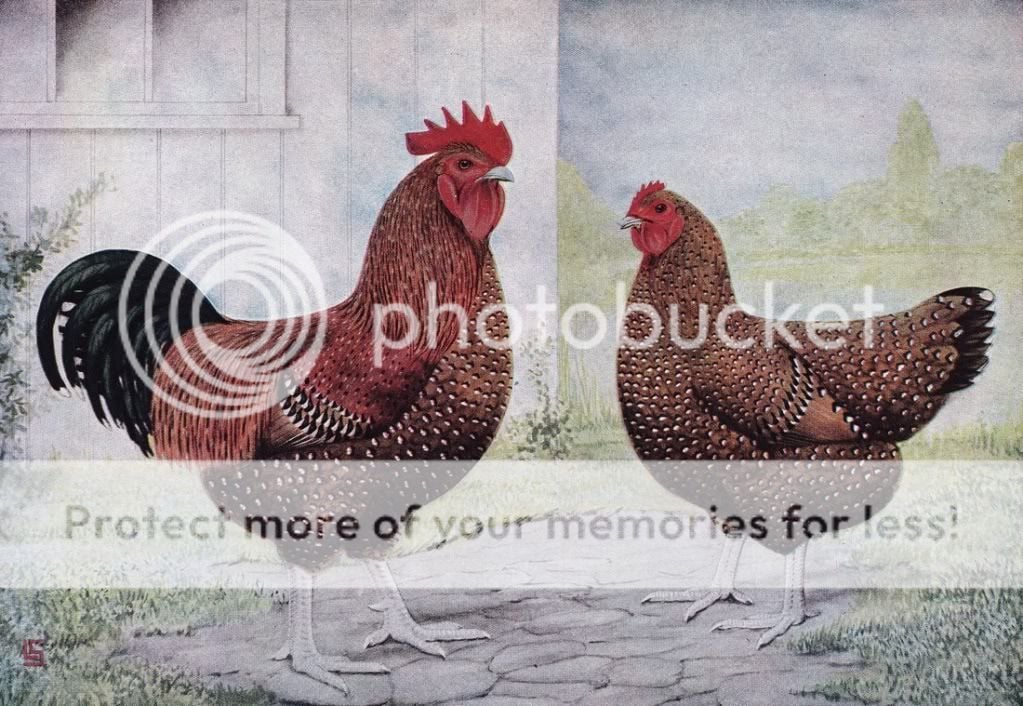speckled sussex - - COME JOIN US!
GENERAL SCALE OF POINTS FOR SHOWING . .. . .
Total Possible sHAPE color
Symmetry 4 4
Weight or Size 4 4
Condition and Vigor 10 10
Comb 5 5
Beak 3 2 1
Skull and Face 4 3 1
Eyes 4 2 2
Wattles 2 2
Earlobes 4 2 2
Neck 6 1 5
Back 12 6 6
Tail 8 4 4
Wings 8 3 5
Breast 10 5 5
Body and Fluff 8 5 3
Legs and Toes 8 5 3
TOTAL 100 63 SHAPE 37 COLOR
STANDARDS - -
DISQUALIFICATIONS:
Yellow skin, shanks, or feet.
Combs: Side Sprigs
COMBS: Lopped Single Comb - - SLIGHTLY lopped comb in female at or near production is not penalized
COMBS: Split combs
TAIL - Split Tail
Tail: Wry Tail
Tail: Rumpless
Tail: Squirrel tail
Tail: twisted feathers
Shanks: Bow leg
Shanks: Knock Knee
Toes: Web foot
FAULTS
Combs: TWISTED comb in front
COMBS: Irregular serration of comb
Combs: Thumb mark
Wattles: Coarse Wrinkled Wattles
Earlobs: Loosely- fitted lobes
WEIGHT - - More than 1 pound over standard or any under standard
Tail - Pinched
TOES: Crooked toe
FEATHERS - - FROSTING Fault Per Section
Standard Of Perfection.....
WEIGHTS: Hen 7 lbs, Pullet 6 lbs, Cock 9 lbs, Cockerel 7 1/2 lbs.
COLOR - MALE
Comb, Face, Wattles, and ear-lobes: Bright Red
Beak: Horn
Eyes: Reddish Bay
Head: PLUMAGE, lustrous mahogany bay, EACH feather tipped with white, a NARROW black bar dividing the white from balance of feather.
Neck: HACKLE, lustrous mahogany bay, each feather having a narrow black stripe in lower half of web, the black stripe decreasing in width near end of feather
and then branching off to outer edge of each side of shaft near point. POINT OF FEATHER distinctly marked with diamond shaped white spangle.
BACK and Saddle ..... SAME as Hackle
Tail: Main tail feathers --- BLACK and WHITE
Sickles, Coverts, and smaller coverts - - - Lustrous, greenish black tipped with white
Wngs:
Fronts and Bows: Lustrous mahogany bay each feather tipped with white, a narrow elongated V shaped black bar dividing white from balance of feather
Coverts: Mahogany bay, each feather tipped with a large white spangle, a black bar dividing the white from balance of feather.
Primaries - - black and white
Secondaries - - outer web, bay edged with white
inner web, black edged with white, each feather ending with a white spangle
Breast:
Mahogany bay, each feather tipped with white, a black bar dividing the white from balance of feather
Body and fluff:
BODY - SAME as BREAST
FLUFF - Slaty Brown
Legs and TOES:
Lower Thighs - Same as BREAST.... except it is specified NARROW black bar
Shanks and Toes - - Pinkish white
UNDERCOLOR of all sections: SLATE, shading to salmon, the salmon shading to light gray at base.
SHAPE of MALE
Comb - - Single Comb... Medium in Size, set firmly on head, perfectly straight and upright, having five well defined points those in front and rear being
smaller than those in the middle. Fine in texture. blade following curve of neck.
Beak - - Stout, rather short, slightly curved
Face - - Surface smooth, skin fine and soft in texture
Eyes - - Large round prominent
Wattles - - Medium in Size. equal in length, well rounded at lower edges
Ear lobes - - medium in size, ovel, smooth
Head - moderately large, broad, medium in length
Neck - medium in length, slightly arched, having abundant hackle flowing well over shoulders.
Back - - Long, Flat broad its entire length, sloping slightly to tail
Saddle feathers - - of med length, abundant and filline well in frount of tail.
Tail -- Of med length, well spread, - - > 45 degree above horizontal
Main tail feathers - - Broad and overlapping
Main sickle - - of medium length, well curved extending slightly beyond mail tail feathers.
Lesser sickle and coverts - - of med length
Wings - - Rather long, well folded, carried closely to body without dropping
Points well covered with saddle feathers.
Breast - - Broad, deep rounding nicely into body
Body - Long Broad Deep
Fluff - Moderately full, fitting closely to body
Legs - - Legs set well apart straight when viewed from front.
Lower Thighs - Stout Of Med Length
Shanks - - med length, rather stout
Toes - - four on each foot, of med length, straight, well spread.
This is a 1920's Sewell print

Hope these will be useful in our discussions......
Around page 19 of this thread. . .we start our discussion on the head with the following specifications
Quote: MOving this up for discussion sake.
Last edited:






